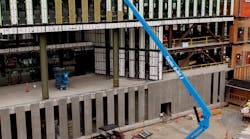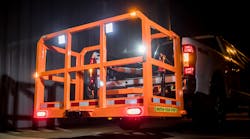Gold Award
ECR25 Electric compact excavator
Volvo Construction Equipment
Original category: Earthmoving
Key innovation: The ECR25 electric compact excavator has zero exhaust emissions, and compared with conventional counterparts, significantly lower noise levels, reduced energy costs, improved efficiency and fewer maintenance needs.
Manufacturer’s description: Volvo CE recognizes that the world is changing and the push for environmental sustainability is only going to increase in the years ahead. A lot of attention has been paid to on-road transportation, such as electric buses and cars, but the sustainability movement is coming to the off-road industry as well.
We are excited to provide sustainability solutions for our customers, and the electric compact excavator was a great place to start because mini-excavators are versatile and in high demand. Volvo electric machines are ideal for applications with low emission requirements, noise regulations or nighttime hours thanks to their zero exhaust emissions and significantly lower noise levels. Another benefit — and cost saving opportunity — is maintenance: electric machines do not require oil, oil filters, diesel particulate filters or DEF. The ECR25 Electric has an onboard charger that can charge overnight via a regular household socket. In addition, an off-board fast charger can bring the excavator to 80-percent power within an hour.
And users get all of these benefits without sacrificing performance. The ECR25 Electric has comparable performance to its conventional diesel equivalent, including a digging depth of 9 feet, 1 inch and breakout force of 5,020 lbf. Our customers’ positive responses validate that there is not only a desire for these types of machines in North America but a pull in many markets.
RER commentary: While concern for environment is a good reason to like Volvo CE’s ECR25 electric compact excavator, there are multiple practical reasons why the product is a strong one and likely to have a significant impact in the rental marketplace. While working on farms is not likely to be the first application that comes to mind, Volvo’s Dr. Ray Gallant, vice president of product management and productivity, is quick to point out the benefits.
“If the customer is working around livestock on a farm, they may not want emissions or noise scaring the livestock, that’s a perfect application for a silent electric machine,” says Gallant. “If they’re working indoors, that’s a perfect application. If you’re working in suburban areas, those are perfect applications.” Those areas are being picked up and contractors are being creative in how they make best use of these machines.
“The other track that we’re seeing is of course the environmentally friendly aspects. There’s a lot of legislation, a lot of movement for companies and government to push towards a greener fleet, a greener footprint. So, a lot of companies are starting to pick up and start the transition to make 10 percent or 20 percent or 50 percent of their fleets electric and be able to market on that and also be better off on the environment. That’s really the two demand pushes. From a production point of view, there’s not much difference between what an electric machine will produce and what a diesel machine will produce. Both will dig a hole, both will move dirt, they both will accomplish the same job.”
There are also significant demographic drivers. “The world is getting more and more towards an urban population, so you have high density population centers where it’s not the greatest place to have fumes and noise going off, so there’s a number of different drivers and society drivers as well,” Gallant says. “Society is demanding that noise levels come down, that emissions are cleaner, machines are cleaner, there’s a whole different demand and set of drivers than there was in traditional diesel equipment 20 years ago or 30 years ago.”
Government jobs are also good opportunities for electric machines. “Typically, a government job in a lot of cases will be regulated, so you have to have so much of your equipment green or zero emission or in some cases all of your equipment of a particular type may have to be electric,” Gallant says. “Municipalities are pushing more and more for contractors to have a green footprint because it helps them with their environmentally friendly position for municipal works.”
Since the machines have only been on the market for a short time, the market demand for them is still developing. At this point, Gallant says there is a lot of interest from larger rental companies, although smaller ones look like good potential customers as well.
“We’re seeing good interest in large rental companies, and part of the reason is they’re the ones best equipped to also have the charging infrastructure available,” he says. “With these machines, in most cases, a rental house will want to re-charge it and be able to put it out there as quicky as possible and you’re also going to want to rent the charging infrastructure to your customer if you can as an additional revenue stream if the customer wants. We’re seeing the larger rental houses start to look at what are the fleet dynamics and looking at the fleet dynamics of their large contractors as well. But we are getting interest from a lot of the smaller rental houses also, asking about specialty applications. They ask, ‘If there’s a contractor that wants to do a job downtown indoors, will this machine work?’ There are pockets of these specialty applications that we’re getting conversations going on.”
How long will the machine operate on a charge?
“We say four to six hours of work but that means real work,” says Gallant. “Electric machines are different than diesel machines because when they are not working, there’s absolutely zero battery drain. Unlike a conventional diesel that may idle 30 percent of the time and be digging 70 percent of the time, with an electric machine you only count the 70 percent of the time that it’s actually digging. So based on that, the four-to-six-hour duty cycle is a typical workday. If you have an application where you actually have an implement or an attachment and every minute of the day the operator is working, you would have to re-charge.”
Price points
When it comes to price points, the sticker price of an electric machine is higher, there’s no doubt about that at this point. However, over the long haul, total costs of ownership might equal out, Gallant notes. The first point is that maintenance costs are considerably less.
“Basically, if you look at electric machines, what we’ve essentially done is taken the engine out and we’re driving through a battery and an electric motor,” he says. “The hydraulics are basically a conventional hydraulic setup, so you still have the hydraulic oil, you still have hydraulic pumps, you still have a maintenance requirement for the hydraulic system. But when you look at most of the maintenance, especially on these small machines, it really is mostly tied to the engine. And most of the failures on smaller machines are tied to the engine as well. Most of your moving parts, the hard-working piece of the machine is the engine component.
“By replacing that with electric drives, we estimate, and this has got to prove out in long-term use, but we estimate about 35 percent savings in maintenance costs and maintenance time over the life of the machine. And we think that’s a very very conservative estimate. Which is part of the total cost equation. When you factor in the maintenance costs, they are considerably less. The longevity of the machine is greater, that you’re only counting actual work hours on your hour meter, you start to get a more reasonable total cost of ownership and a more comparable total cost of ownership picture.”
Technology evolution
Maintenance costs and fuel costs are significantly cheaper with the ECR25. And the way the technology is likely to evolve over the coming years, costs of ownership might balance out even more favorably towards the electric.
“These are introductory machines, these are the first using these new emerging technologies,” says Gallant. “I think you’re going to see a lot of change in the infrastructure around them. You’re going to see a lot more electric attachments, you’re going to see faster charging methods come in, so instead of the one-hour quick charge that we’re talking about now, you will see systems that will re-charge the batteries in 15 or 20 minutes. We’ll see portable charging. So you’ll have a fuel cell for instance that’s powering a charger that you can take out to your machine, plug it in for 20 minutes and the machine will be fully re-charged. I think those are the developments that we’ll see proliferating.
“And when you get into heavy equipment, you’ll see a whole different suite of technologies that are going to come into play. All of this is bringing energy consciousness and energy efficiency into top of mind. So it’s not only how do you burn clean, but how do you burn efficient? We’ve been spoiled with a phenomenally efficient fuel in diesel from an energy point of view, but we haven’t been very good at taking advantage of all that energy. With electric it’s a lot easier to take advantage of a much higher percentage of the electric energy that is there.“
There are some additional engineering benefits to electric machines.
“Because electric motors have full torque at 1 RPM at whatever speed you run them at, the response rate of these machines, the power that you feel that you have when you’re sitting in the operator’s seat is actually superior to a diesel piece of equipment in many cases,” says Gallant. “The other advantage is that the batteries have a lot of weight and by positioning that weight properly, we’re able to take advantage of that weight for the center of balance of the machine and/or the counterweight in the case of an ECR25. We can set those batteries in the back of the machine and it becomes very stable because you have a lot of weight on your tail.”








